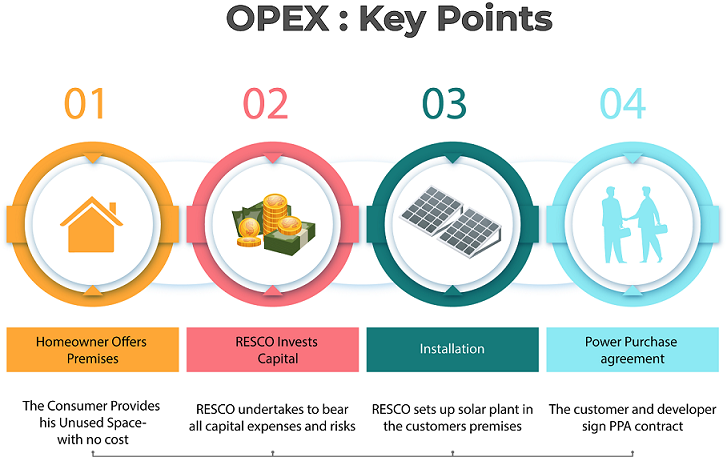Introduction:
The solar industry has witnessed tremendous growth in recent years, with an increasing number of individuals and businesses adopting solar power. A significant factor contributing to this widespread adoption is the introduction of innovative financing models, such as the OPEX (Operational Expenditure) or RESCO (Renewable Energy Service Company) model. This model has revolutionized the way solar energy projects are financed and managed, making solar power more accessible and affordable for consumers.
Understanding the OPEX/RESCO Model:
The OPEX/RESCO model is an innovative financing approach where a third-party company invests, installs, operates, and maintains a solar power system on a customer’s property. In return, the customer pays for the solar power generated by the system, either through a Power Purchase Agreement (PPA) or a fixed monthly fee. This model has gained popularity in India and around the world, as it allows customers to adopt solar power without making a large upfront investment.
Key Features of the OPEX/RESCO Model:
No upfront cost: Customers do not have to make any significant upfront investment for the solar system installation, making solar power more affordable and accessible.
Third-party ownership: The solar system is owned and maintained by the third-party company or the RESCO, reducing the responsibilities of the customer.
Pay-for-use: Customers pay for the solar power generated by the system at a pre-agreed rate, typically lower than grid electricity prices, resulting in cost savings.
Maintenance and operation: The RESCO is responsible for the operation, maintenance, and repair of the solar system throughout the contract period, ensuring optimal performance and reducing the hassle for the customer.
Key Players in the OPEX/RESCO Model in India and Globally:
The OPEX/RESCO model has attracted several key players in the solar industry, both in India and around the world. These companies have played a crucial role in driving solar power adoption by offering flexible financing options and taking responsibility for the operation and maintenance of the solar systems.
Some of the key players in the OPEX/RESCO model for the solar industry in India include:
- CleanMax Solar
- Tata Power Solar
- Fourth Partner Energy
- Amplus Solar
- Azure Power
Globally, some prominent companies in the OPEX/RESCO model are:
- Sunrun (USA)
- SunPower (USA)
- SolarCity (USA, now part of Tesla)
- Vivint Solar (USA)
- Canadian Solar (Canada)
Potential clients for Power Purchase Agreements (PPAs) in the RESCO model in India include:
- Large industries and commercial establishments: Factories, manufacturing units, malls, and office complexes can benefit from solar energy to meet their electricity needs and reduce energy costs.
- Educational institutions: Schools, colleges, and universities can opt for RESCO model PPAs to power their campuses and promote sustainability.
- Government institutions and public sector undertakings (PSUs): Government buildings, PSUs, and public infrastructure can utilize RESCO model PPAs for meeting their energy requirements while reducing their carbon footprint.
- Hospitals and healthcare facilities: RESCO model PPAs can help hospitals and healthcare facilities save on electricity costs while contributing to a greener future.
- Residential societies and real estate developers: Large residential societies and real estate developers can implement solar projects under the RESCO model to offer sustainable and cost-effective power solutions to residents.
- Hotels and resorts: The hospitality sector can use RESCO model PPAs to power their properties, reducing electricity costs and promoting eco-friendly practices.
- Telecom and data centers: With high energy demands, telecom companies and data centers can benefit from the RESCO model to meet their power needs while lowering energy expenses.
- Small and medium-sized enterprises (SMEs): SMEs can use RESCO model PPAs to reduce their operational costs by adopting solar energy without making significant upfront investments.
These clients can benefit from the RESCO model by entering into PPAs with solar developers, who take care of project development, financing, installation, and maintenance. The clients then purchase the generated electricity at an agreed-upon rate for a specified contract period, often with lower electricity costs than traditional grid power.
Conclusion:
The OPEX/RESCO model has been a game-changer in the solar industry, making solar power more accessible and affordable for customers worldwide. With the support of key players in the industry, this financing model is expected to continue driving the growth of solar power adoption in India and globally, contributing to a more sustainable and greener future.

